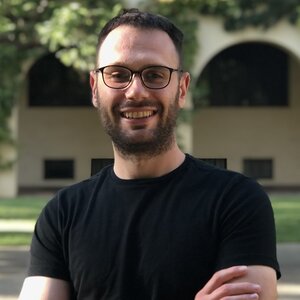
Where this story truly begins is difficult to say.
It could be somewhere in the early nineteenth century, when mathematician Ernst Eduard Kummer began experimenting with cubic Gauss sums, leading him to record a conjecture that would remain open for more than 150 years. Or perhaps this story picks up in the 1950s, when physicist Hedvig Selberg programmed a vacuum-tube computer to calculate around 600 sums—twice—to help John von Neumann and Herman Goldstine test Kummer’s theory. One might also argue that this story’s true origins go back to the University of Cambridge, where Samuel J. Patterson, hooked on this mystery surrounding cubic Gauss sums, replaced Kummer’s conjecture with his own. But for Alexander Dunn (PhD, 2020, mathematics) and his mentor Maksym Radziwiłł, the story began in a parking lot in Pasedena, California.
According to an article in Quanta magazine, Dunn and Radziwiłł spent months trying to find an answer that had eluded mathematicians for ages: if you were to plot all the infinitely possible cubic Gauss sums, how evenly would they be distributed?
Kummer’s 1846 conjecture suggested the pattern would not be random. Though he was only able to calculate 45 sums in total, he found they were distributed in an odd, but orderly way, clustering around a value of 1: most results fell between 1/2 and 1; fewer between –1/2 and 1/2; and even fewer between –1 and –1/2. When Selberg, Goldstein, and von Neumann ran their calculations, they discovered that as the primes increased, the sums appeared to be distributed more randomly. Though they hadn’t necessarily disproven Kummer’s theory, they certainly hadn’t proven it. This curiosity led number theorists to study the Kummer conjecture regarding cubic Gauss sums with a particular intensity for the next several decades. Though advances on the problem were made, it remained open. However, in 1978, Samuel Patterson made revised conjecture. Patterson speculated that the sum of all the cubic Gauss sums for primes less than N is roughly N5/6. His conjecture implied that cubic Gauss sums behave like sums of random numbers, but that they are influenced by a weak bias towards positive values. In other words, it would explain the conflicting observations of Kummer and the IAS researchers.
Patterson refined his conjecture further in 1979 with Roger Heath-Brown, who would later develop a tool called the large cubic sieve that could relate the sum of cubic Gauss sums to a different sum, making their values easier to infer. Though his use of the cubic large sieve did not definitively prove Patterson’s initial conjecture, it provided supporting evidence. At the time, Heath-Brown thought the sieve could be improved. In a paper he published in 2000, he noted what he thought would be the best formula for the sieve, believing it to be a superior version that could one-day help prove Patterson’s conjecture.
As it turned out, Heath-Brown’s work would ultimately lead mathematicians to prove Patterson’s conjecture, but not in the way he imagined. After much laborious and complicated work, Dunn and Radziwiłł discovered the new formula posited by Heath-Brown—one that had been largely accepted by modern number theorists—wasn’t correct.
Determining that the large cubic sieve could not be improved helped Dunn and Radziwiłł approach the task from a different angle, and in the end, they triumphed. After 175 years, the question Kummer had posed to the mathematical community finally had an answer: Patterson’s conjecture had been right, and Dunn and Radziwiłł had proven it. Part of the sieve Heath-Brown had initially developed still proved invaluable to Dunn and Radzwiłł; in the paper they posted on September 15, 2021, they included the following note: “An important ingredient in our proof is a dispersion estimate for cubic Gauss sums. It can be interpreted as a cubic large sieve with correction by a non-trivial asymptotic main term.”
Dunn points out that his work isn’t the first time that a UIUC affiliate has gotten involved with the mystery surrounding the Kummer conjecture. Mathematical Reviews® is a journal published by the American Mathematical Society (AMS) that provides information on peer-reviewed articles and books, and it was Professor Emeritus Bruce Berndt who wrote the “math review” of Patterson’s 1978 paper. One line from Berndt review reads “One aim of the present paper is to bring Kummer’s conjecture back to respectability and to enunciate a more precise version of this conjecture.” Dunn and Radziwiłł’s work has done just that.
Though Dunn and Radziwiłł’s proof is conditional on the generalized Riemann hypothesis, an infamously open conjecture in mathematics, Leila Sloman explains in her piece for Quanta Magazine that many mathematicians agree that a conditional result is still a huge triumph. When the news of Dunn and Radziwiłł’s accomplishment rolled into the Department of Mathematics at Illinois, the number theory research group rejoiced.
“This is a tour de force in analytic number theory,” says Scott Ahlgren, professor of mathematics at Illinois and Dunn’s former advisor. “It proves an old and beautiful conjecture and sheds new light on the large sieve (one of the fundamental tools of analytic number theory). And it seems certain that the methods of this paper will find many future applications.”
Dunn credits his education from the Illinois Department of Mathematics as crucial to his success: “I would like to thank the number theory group at UIUC for the training and support I received [while earning] my PhD. In particular, I would like to acknowledge my advisors Scott Ahlgren and Alexandru Zaharescu. Without the opportunity to study at UIUC, I wouldn't have been prepared to tackle research problems like this one.”